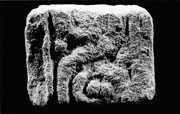Select a site alphabetically from the choices shown in the box below. Alternatively, browse sculptural examples using the Forward/Back buttons.
Chapters for this volume, along with copies of original in-text images, are available here.
Object type: Fragment of cross-shaft(?)[1]
Measurements: H. 18.75 cm (7.4 in); W. 31.5 cm (12.4 in); D. 21.3 cm (8.4 in)
Stone type: Medium- to coarse-grained, yellow (10YR 7/8) grit; see no. 2.
Plate numbers in printed volume: 30-33
Corpus volume reference: Vol 3 p. 58
(There may be more views or larger images available for this item. Click on the thumbnail image to view.)
A (broad): The flat edge moulding is quite wide. Within the panel are two mirror image, sinuous elements, free from each other, with snake head (or leaf) terminals.
B (narrow): A broad, flat edge moulding, somewhat damaged, flanks worn, alternating spiral scrolls with pellets in the spandrels.
C (broad): The flat edge moulding flanks what appears to be a serpent, its body executed in broad, median-incised strands. These are arranged as a unit of what is probably simple pattern F, set horizontally. It has a tapering tail and a leaf-like head.
D (narrow): The broad, flat edge moulding contains part of an interlace: a long glide separates two units of interlace, probably a form of pattern F, or free rings and long diagonals.
The scroll and pellet, as well as the ring-twist are common on Anglo-Scandinavian monuments throughout Northern England, especially on the hogback series (Lang 1984a, 105–6). Simplified scroll and pellet continue to appear as a surviving motif throughout the tenth century. The serpents are unusual in their formal layout but the heads should be compared (as well as the interlace) with no. 46, the damaged hogback (Ills. 187–9), which is probably by the same hand.
1. All the pieces from the Minster were discovered as a result of the excavations of 1966-71 by H. Ramm and D. Phillips. They are to be published as a handlist, together with a critical essay, in the forthcoming Royal Commission volume on the excavations. That publication will provide the finer detail of their archaeological contexts, both in a table, and in a description of the excavation of the south transept cemetery.
The following are general references to the stones: Wilson 1978, 142; Hall 1980b, 7, 21; Lang 1988b, 8, 12; Lang 1989, 5.



